Orthodontists specialize in diagnosing, preventing, and correcting misaligned teeth and jaws using braces, aligners, and other dental appliances. Prosthodontists focus on restoring and replacing teeth through crowns, bridges, dentures, and dental implants to improve function and aesthetics. Both dental specialists play crucial roles in comprehensive oral care, with orthodontists enhancing alignment and prosthodontists restoring structure.
Table of Comparison
| Aspect | Orthodontist | Prosthodontist |
|---|---|---|
| Specialization | Diagnosis and correction of teeth alignment and bite issues | Restoration and replacement of teeth with prosthetics |
| Common Treatments | Braces, clear aligners, retainers | Dental implants, crowns, bridges, dentures |
| Training | 3 years of orthodontic residency after dental school | 3 years of prosthodontic residency after dental school |
| Focus Area | Correcting malocclusion and teeth positioning | Reconstructing teeth and oral function |
| Patient Cases | Misaligned teeth, overbite, underbite | Missing teeth, damaged teeth needing restoration |
| Goal | Improve bite function and cosmetic smile alignment | Restore chewing ability and facial aesthetics |
Introduction to Orthodontists and Prosthodontists
Orthodontists specialize in diagnosing and correcting misaligned teeth and jaws using braces, aligners, and other dental appliances to improve bite and aesthetics. Prosthodontists focus on restoring and replacing teeth through crowns, bridges, dentures, and dental implants to enhance oral function and appearance. Both dental specialists play critical roles in comprehensive oral healthcare but address distinct aspects of dental treatment.
Core Responsibilities of Orthodontists
Orthodontists specialize in diagnosing, preventing, and correcting misaligned teeth and jaws using braces, aligners, and other orthodontic appliances. Their core responsibilities include creating treatment plans to improve bite function and aesthetics, monitoring patient progress, and managing growth-related dental issues primarily in adolescents and adults. Unlike prosthodontists, who focus on restoring and replacing teeth, orthodontists center on guiding teeth alignment and jaw development.
Core Responsibilities of Prosthodontists
Prosthodontists specialize in restoring and replacing teeth through dental prosthetics such as crowns, bridges, dentures, and implants to improve oral function and aesthetics. Their core responsibilities include diagnosing complex dental and facial issues, designing customized treatment plans, and fabricating precise dental restorations for patients with missing or damaged teeth. Expertise in advanced restorative techniques and materials enables prosthodontists to enhance patients' chewing ability, speech, and overall oral health.
Educational Pathways and Qualifications
Orthodontists complete dental school followed by a 2-3 year residency specializing in diagnosing and correcting misaligned teeth and jaws, earning certification in orthodontics. Prosthodontists undergo dental school and then pursue an additional 3-year residency focused on restoring and replacing teeth with prosthetics such as crowns, bridges, and dentures, obtaining prosthodontic board certification. Both specialists require rigorous clinical training and must pass comprehensive exams to achieve licensure specific to their fields.
Essential Skills and Expertise Required
Orthodontists require expertise in diagnosing and correcting dental misalignments through braces, aligners, and other appliances, with strong skills in biomechanics and craniofacial growth. Prosthodontists specialize in restoring and replacing teeth using crowns, bridges, dentures, and implants, demanding proficiency in esthetic design, occlusion, and materials science. Both disciplines require comprehensive knowledge of oral anatomy, patient assessment, and treatment planning but differ significantly in their technical focus and clinical applications.
Treatment Approaches and Methodologies
Orthodontists specialize in diagnosing and correcting misaligned teeth and jaws using braces, aligners, and other orthodontic appliances to improve dental function and aesthetics. Prosthodontists focus on restoring and replacing missing or damaged teeth through crowns, bridges, dentures, and dental implants, emphasizing functional and esthetic rehabilitation. Both disciplines employ advanced imaging techniques and digital treatment planning to customize patient-specific interventions for optimal oral health outcomes.
Types of Patients and Cases Handled
Orthodontists specialize in diagnosing and treating malocclusions and irregularities in teeth alignment, often managing cases involving braces, clear aligners, and jaw growth issues primarily in adolescents and adults seeking orthodontic correction. Prosthodontists focus on restoring and replacing teeth, dealing with complex cases such as dental implants, crowns, bridges, dentures, and full mouth reconstructions, catering mainly to patients with significant tooth loss, damage, or congenital defects. Both specialists collaborate with general dentists but serve distinct patient needs based on the nature of dental irregularities or restorative requirements.
Work Environments and Practice Settings
Orthodontists typically work in specialized dental clinics or multi-disciplinary dental offices, focusing on correcting teeth alignment using braces and aligners. Prosthodontists are often found in hospital dental departments, private prosthodontic practices, or academic institutions, where they repair and replace teeth with crowns, bridges, and dentures. Both specialists may collaborate with general dentists but serve distinct roles depending on the patient's dental restoration and alignment needs.
Career Growth and Advancement Opportunities
Orthodontists and prosthodontists both offer specialized dental care with distinct career growth pathways; orthodontists often advance by leading orthodontic departments or developing innovative alignment technologies, while prosthodontists may expand their expertise through complex restorative procedures and research in dental prosthetics. The demand for orthodontists is driven by increasing awareness of dental aesthetics and pediatric care, whereas prosthodontists experience growth through aging populations requiring advanced reconstructive treatments. Both specialties benefit from opportunities in academia, clinical research, and private practice ownership, providing diverse avenues for professional advancement.
Choosing Between Orthodontics and Prosthodontics
Choosing between an orthodontist and a prosthodontist depends on the dental needs focused on alignment versus restoration. Orthodontists specialize in correcting tooth and jaw alignment using braces or clear aligners, enhancing functional bite and aesthetic appearance. Prosthodontists concentrate on restoring damaged or missing teeth through crowns, bridges, dentures, and implants to improve oral function and smile restoration.
Orthodontist vs Prosthodontist Infographic

 jobdiv.com
jobdiv.com